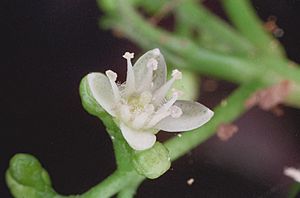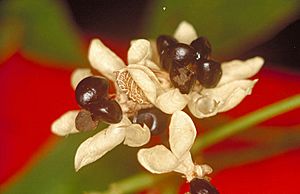False euodia facts for kids
Quick facts for kids False euodia |
|
|---|---|
 |
|
| Scientific classification | |
| Genus: |
Melicope
|
| Species: |
broadbentiana
|
| Synonyms | |
|
|
The Melicope broadbentiana, often called false euodia, is a type of shrub or tree. It belongs to the Rutaceae family, which also includes citrus fruits like oranges and lemons! This plant is special because it is endemic to Queensland, Australia. This means it naturally grows only in that area.
False euodia plants can have two kinds of leaves: simple leaves (just one blade) or trifoliate leaves (three leaflets joined together). Sometimes, a single plant can even have both! It also produces small white flowers that grow in clusters called panicles, usually where the leaves meet the stem.
Contents
What Does False Euodia Look Like?
The false euodia is usually a tree that can grow up to 20 meters (about 65 feet) tall. But sometimes, it can be a smaller shrub and still produce flowers and fruit.
Leaves and Stems
The leaves of the false euodia grow in pairs, one opposite the other.
- Simple leaves: These are shaped like an egg or an oval. They are usually 40 to 100 millimeters (about 1.5 to 4 inches) long and 15 to 40 millimeters (about 0.6 to 1.5 inches) wide. They have a small stem called a petiole that is 10 to 30 millimeters long.
- Trifoliate leaves: The main leaflet of these leaves is also oval-shaped. It can be 45 to 160 millimeters (about 1.7 to 6.3 inches) long and 15 to 55 millimeters (about 0.6 to 2.2 inches) wide. Its petiole is a bit longer, from 20 to 90 millimeters.
Flowers and Fruit
The flowers of the false euodia are small and white. They grow in clusters (panicles) that are 13 to 60 millimeters long. These clusters appear where the leaves join the stem.
- Flower types: Some flowers have both male and female parts (bisexual). Others are only male or only female.
- Petals and Sepals: The flowers have small, egg-shaped sepals (leaf-like parts at the base of the flower) that are about 1 to 1.3 millimeters long. The white petals are a bit longer, about 2.5 to 3.5 millimeters.
- Stamens: If the flower has male parts, it will have four stamens (which produce pollen). These stamens are arranged in a special way with four shorter parts called staminodes.
- Flowering time: You can see false euodia flowers in most months of the year!
- Fruit: After flowering, the plant produces fruit. Each fruit is made up of up to four small pods called follicles, which are 9 to 12 millimeters long and joined at the base.
How False Euodia Got Its Name
The false euodia was first officially described in 1891 by a scientist named Frederick Manson Bailey. He wrote about it in a special book called the Botany Journal of the Department of Agriculture, Queensland. The plants he studied were found high up on Mount Bellenden Ker, about 4000 feet (1200 meters) above sea level.
Where False Euodia Grows
This plant loves to grow in rainforests. You can find it from areas right by the sea all the way up to mountains as high as 1500 meters (about 4900 feet). In Queensland, Australia, it grows in a specific region between the Mount Spurgeon National Park and the Paluma Range National Park.
Is False Euodia Protected?
Good news! The false euodia is not considered to be in danger. The Queensland Government has classified it as a species of "least concern" under their Nature Conservation Act 1992. This means there are plenty of these plants in the wild.



